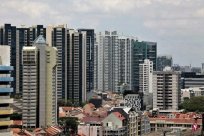Society
Shinzo, Prime Minister, Prime Minister of Japan, who has just re -elected as the President of the Liberal Democratic Party, ended three days of visit to China on October 27.This is a Japanese Prime Minister's visit to China after seven years, showing that China and Japan intend to thaw bilateral relations.The biggest thrust behind this is undoubtedly the unilateralist policy of US President Trump.
In the face of the tremendous pressure of the Sino -US trade war, Beijing must seek high -tech and funds required for development from Tokyo; after signing a new trade agreement with Washington in Canada, Mexico and South Korea in Canada, Mexico, and South Korea, they must also plan for their own export trade.EssenceAbe's trip may symbolize the relationship between the two countries. It is expected to go out of ideological entanglement and develop to normal great powers.
More than 500 members of the Japanese company delegation accompanied Abe's visit to China show that the two countries attach great importance to the restoration of economic relations.Chinese Prime Minister Li Keqiang revealed that China -Japan enterprises have reached a cooperation agreement with a total value of about 25 billion yuan.The two sides also discussed cooperation in the fields of third -party markets.The two countries signed a total value of about 39.7 billion yuan, a three -year bilateral currency exchange agreement; the Bank of China Tokyo Branch was authorized to liquidate the RMB business.This will facilitate the use of RMB in Japanese financial institutions.
In Beijing's grand reception this time, Abe visited, not only arranged for the ceremony of the three -arm guard review ceremony of the 19th ritual cannon. The leader and prime minister of the President Li Keqiang met him in the Great Hall of the People.Activities; China Leaders also set up a dinner party to entertain Abe in Diaoyutai State Hotel.
Tiananmen Square is rarely hung on the Japanese flag.Sino -Japanese leaders have unanimously stated that bilateral relations have entered the right track.Abe said that he hopes to lead the leaders of China and lead Sino -Japanese relations to a new era from competition to cooperation.Chinese leaders said that with the changes in the international situation, the mutual dependence of China and Japan is increasing; the rapid changes in the world provide opportunities for China and Japan to deepen cooperation.Japanese media reported that Chinese leaders complained to Abe that he opposed the single -pole world led by the United States.
Because of the Washington Trade War and the pressure imposed in the security field, it is necessary to use Japan as a buffer motivation to see Beijing's pragmatic attitude towards Japan.In this time, not only did not make articles in the history of Japanese invasion in Japan, but also 71 members of the Cabinet House, Deputy Minister of Japan's Cabinet House, collectively visited the Yasukuni Shrine on October 18.In mid -September, Japan dispatched submarines and helicopters for the first time, and a military exercise was held in the South China Sea. China did not have a strong protest.
On the occasion of Abe's 40th anniversary of the establishment of diplomatic relations between China and China and Japan, Japan announced that it would stop the government development assistance (ODA).Chinese media affirmed the contribution of development assistance to China's modernization.Since 1979, Japan has provided a total of 44.7 billion yuan in loans, funding and technological transfer of 44.7 billion yuan in China.China surpassed Japan in 2012 and became the world's second largest economy.
The two sides avoided some difficult topics in order to highlight the access to the friendly atmosphere, showing how the United States priority is forced to adopt the reality of pragmatic diplomacy in China and Japan.In other words, although Abe's visit to China helps to adjust China -Japan diplomatic tone, it cannot fundamentally change the structural competition between the two sides.China does not emphasize the issue of the Diaoyu Islands / Saita Islands with sovereignty disputes, but it has no further statement on the threat of the North Korean nuclear threat that Japan is concerned about.Chinese leaders did not clearly accept Abe's invitation to attend the 2020 Tokyo Olympics.Although Japan agrees to cooperate in the third -party market, Japan avoids publicly affirming China's Belt and Road strategy.
After returning home, Abe immediately greets the visiting Indian Prime Minister Modi.Abe pushed the Indian Ocean MDASH; Pacific Diplomacy has been promoted to the Indo -Pacific strategy by Trump.International public opinion believes that its intention to rise in China is quite obvious.
US Vice President Pence criticized China on October 4 to interfere with the US's intervention in the United States, which was described as a new Cold War by international media.Sino -US relations are tense, forcing Beijing to seek improvement of relations with neighboring countries, and Abe's visit to China just provides opportunities.Although Japan must rely on the U.S. military umbrella, Trump lacks the U.S. priority policy that has a clear sense of direction. Especially in the diplomacy, it does not follow the card of the DPRK to make a card in order to make Tokyo face the pressure of Washington's trade pressure.The stability of the United States and Japan Alliance.Improve relations with China will help alleviate this sense of anxiety.
The changes in the global geopolitical pattern opened by Trump have prompted China and Japan to improve the actual improvement of the relationship required by China and Japan.Although the structural contradiction between the two parties cannot be resolved in the short term, China -Japan friendship is still pleasing to regional countries.


